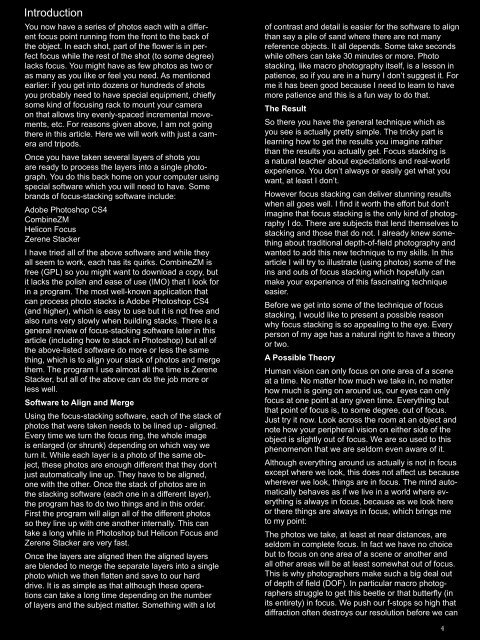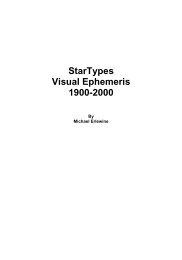The Art of Focus Stacking - Matrix Software
The Art of Focus Stacking - Matrix Software
The Art of Focus Stacking - Matrix Software
Create successful ePaper yourself
Turn your PDF publications into a flip-book with our unique Google optimized e-Paper software.
Introduction<br />
You now have a series <strong>of</strong> photos each with a different<br />
focus point running from the front to the back <strong>of</strong><br />
the object. In each shot, part <strong>of</strong> the flower is in perfect<br />
focus while the rest <strong>of</strong> the shot (to some degree)<br />
lacks focus. You might have as few photos as two or<br />
as many as you like or feel you need. As mentioned<br />
earlier: if you get into dozens or hundreds <strong>of</strong> shots<br />
you probably need to have special equipment, chiefly<br />
some kind <strong>of</strong> focusing rack to mount your camera<br />
on that allows tiny evenly-spaced incremental movements,<br />
etc. For reasons given above, I am not going<br />
there in this article. Here we will work with just a camera<br />
and tripods.<br />
Once you have taken several layers <strong>of</strong> shots you<br />
are ready to process the layers into a single photograph.<br />
You do this back home on your computer using<br />
special s<strong>of</strong>tware which you will need to have. Some<br />
brands <strong>of</strong> focus-stacking s<strong>of</strong>tware include:<br />
Adobe Photoshop CS4<br />
CombineZM<br />
Helicon <strong>Focus</strong><br />
Zerene Stacker<br />
I have tried all <strong>of</strong> the above s<strong>of</strong>tware and while they<br />
all seem to work, each has its quirks. CombineZM is<br />
free (GPL) so you might want to download a copy, but<br />
it lacks the polish and ease <strong>of</strong> use (IMO) that I look for<br />
in a program. <strong>The</strong> most well-known application that<br />
can process photo stacks is Adobe Photoshop CS4<br />
(and higher), which is easy to use but it is not free and<br />
also runs very slowly when building stacks. <strong>The</strong>re is a<br />
general review <strong>of</strong> focus-stacking s<strong>of</strong>tware later in this<br />
article (including how to stack in Photoshop) but all <strong>of</strong><br />
the above-listed s<strong>of</strong>tware do more or less the same<br />
thing, which is to align your stack <strong>of</strong> photos and merge<br />
them. <strong>The</strong> program I use almost all the time is Zerene<br />
Stacker, but all <strong>of</strong> the above can do the job more or<br />
less well.<br />
S<strong>of</strong>tware to Align and Merge<br />
Using the focus-stacking s<strong>of</strong>tware, each <strong>of</strong> the stack <strong>of</strong><br />
photos that were taken needs to be lined up - aligned.<br />
Every time we turn the focus ring, the whole image<br />
is enlarged (or shrunk) depending on which way we<br />
turn it. While each layer is a photo <strong>of</strong> the same object,<br />
these photos are enough different that they don’t<br />
just automatically line up. <strong>The</strong>y have to be aligned,<br />
one with the other. Once the stack <strong>of</strong> photos are in<br />
the stacking s<strong>of</strong>tware (each one in a different layer),<br />
the program has to do two things and in this order.<br />
First the program will align all <strong>of</strong> the different photos<br />
so they line up with one another internally. This can<br />
take a long while in Photoshop but Helicon <strong>Focus</strong> and<br />
Zerene Stacker are very fast.<br />
Once the layers are aligned then the aligned layers<br />
are blended to merge the separate layers into a single<br />
photo which we then flatten and save to our hard<br />
drive. It is as simple as that although these operations<br />
can take a long time depending on the number<br />
<strong>of</strong> layers and the subject matter. Something with a lot<br />
<strong>of</strong> contrast and detail is easier for the s<strong>of</strong>tware to align<br />
than say a pile <strong>of</strong> sand where there are not many<br />
reference objects. It all depends. Some take seconds<br />
while others can take 30 minutes or more. Photo<br />
stacking, like macro photography itself, is a lesson in<br />
patience, so if you are in a hurry I don’t suggest it. For<br />
me it has been good because I need to learn to have<br />
more patience and this is a fun way to do that.<br />
<strong>The</strong> Result<br />
So there you have the general technique which as<br />
you see is actually pretty simple. <strong>The</strong> tricky part is<br />
learning how to get the results you imagine rather<br />
than the results you actually get. <strong>Focus</strong> stacking is<br />
a natural teacher about expectations and real-world<br />
experience. You don’t always or easily get what you<br />
want, at least I don’t.<br />
However focus stacking can deliver stunning results<br />
when all goes well. I find it worth the effort but don’t<br />
imagine that focus stacking is the only kind <strong>of</strong> photography<br />
I do. <strong>The</strong>re are subjects that lend themselves to<br />
stacking and those that do not. I already knew something<br />
about traditional depth-<strong>of</strong>-field photography and<br />
wanted to add this new technique to my skills. In this<br />
article I will try to illustrate (using photos) some <strong>of</strong> the<br />
ins and outs <strong>of</strong> focus stacking which hopefully can<br />
make your experience <strong>of</strong> this fascinating technique<br />
easier.<br />
Before we get into some <strong>of</strong> the technique <strong>of</strong> focus<br />
stacking, I would like to present a possible reason<br />
why focus stacking is so appealing to the eye. Every<br />
person <strong>of</strong> my age has a natural right to have a theory<br />
or two.<br />
A Possible <strong>The</strong>ory<br />
Human vision can only focus on one area <strong>of</strong> a scene<br />
at a time. No matter how much we take in, no matter<br />
how much is going on around us, our eyes can only<br />
focus at one point at any given time. Everything but<br />
that point <strong>of</strong> focus is, to some degree, out <strong>of</strong> focus.<br />
Just try it now. Look across the room at an object and<br />
note how your peripheral vision on either side <strong>of</strong> the<br />
object is slightly out <strong>of</strong> focus. We are so used to this<br />
phenomenon that we are seldom even aware <strong>of</strong> it.<br />
Although everything around us actually is not in focus<br />
except where we look, this does not affect us because<br />
wherever we look, things are in focus. <strong>The</strong> mind automatically<br />
behaves as if we live in a world where everything<br />
is always in focus, because as we look here<br />
or there things are always in focus, which brings me<br />
to my point:<br />
<strong>The</strong> photos we take, at least at near distances, are<br />
seldom in complete focus. In fact we have no choice<br />
but to focus on one area <strong>of</strong> a scene or another and<br />
all other areas will be at least somewhat out <strong>of</strong> focus.<br />
This is why photographers make such a big deal out<br />
<strong>of</strong> depth <strong>of</strong> field (DOF). In particular macro photographers<br />
struggle to get this beetle or that butterfly (in<br />
its entirety) in focus. We push our f-stops so high that<br />
diffraction <strong>of</strong>ten destroys our resolution before we can<br />
4

















